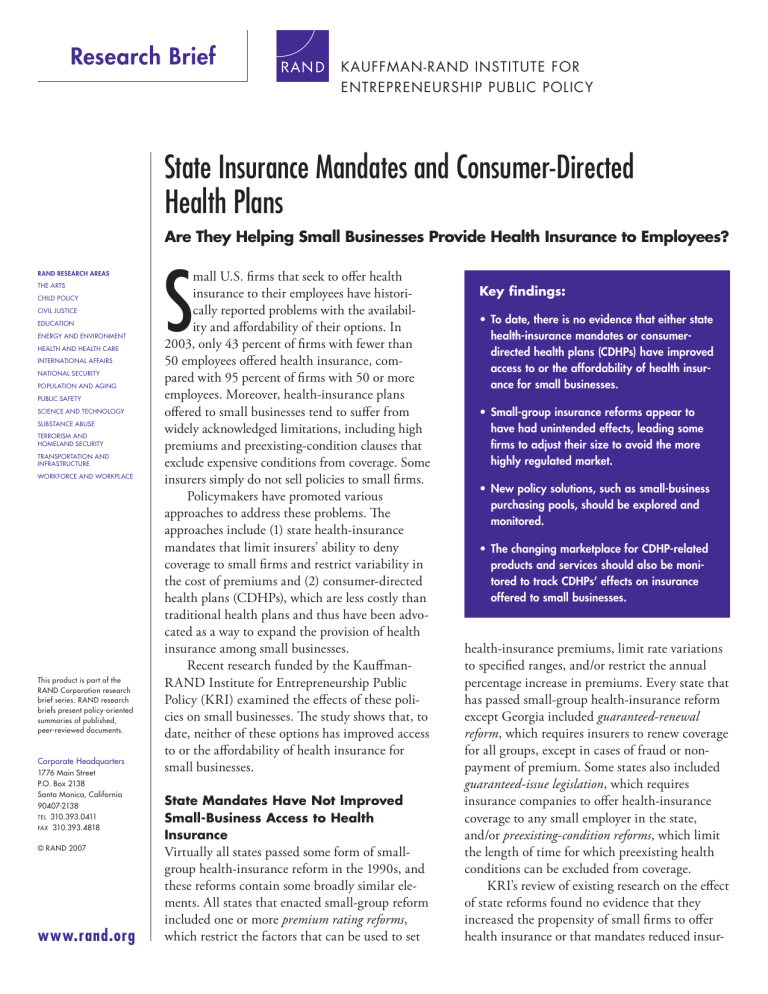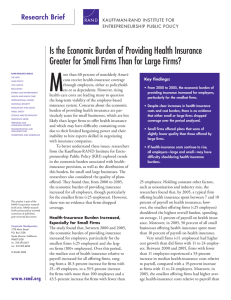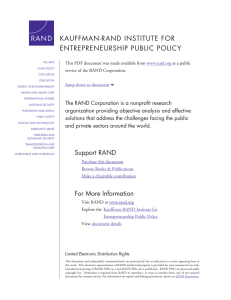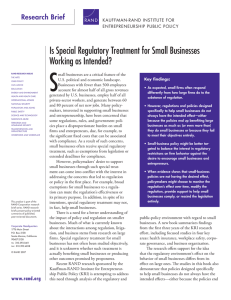S State Insurance Mandates and Consumer-Directed Health Plans Research Brief
advertisement

Research Brief KAUFFMAN-RAND INSTITUTE FOR ENTREPRENEURSHIP PUBLIC POLICY State Insurance Mandates and Consumer-Directed Health Plans Are They Helping Small Businesses Provide Health Insurance to Employees? RAND RESEARCH AREAS THE ARTS CHILD POLICY CIVIL JUSTICE EDUCATION ENERGY AND ENVIRONMENT HEALTH AND HEALTH CARE INTERNATIONAL AFFAIRS NATIONAL SECURITY POPULATION AND AGING PUBLIC SAFETY SCIENCE AND TECHNOLOGY SUBSTANCE ABUSE TERRORISM AND HOMELAND SECURITY TRANSPORTATION AND INFRASTRUCTURE WORKFORCE AND WORKPLACE This product is part of the RAND Corporation research brief series. RAND research briefs present policy-oriented summaries of published, peer-reviewed documents. Corporate Headquarters 1776 Main Street P.O. Box 2138 Santa Monica, California 90407-2138 TEL 310.393.0411 FAX 310.393.4818 © RAND 2007 www.rand.org S mall U.S. firms that seek to offer health insurance to their employees have historically reported problems with the availability and affordability of their options. In 2003, only 43 percent of firms with fewer than 50 employees offered health insurance, compared with 95 percent of firms with 50 or more employees. Moreover, health-insurance plans offered to small businesses tend to suffer from widely acknowledged limitations, including high premiums and preexisting-condition clauses that exclude expensive conditions from coverage. Some insurers simply do not sell policies to small firms. Policymakers have promoted various approaches to address these problems. The approaches include (1) state health-insurance mandates that limit insurers’ ability to deny coverage to small firms and restrict variability in the cost of premiums and (2) consumer-directed health plans (CDHPs), which are less costly than traditional health plans and thus have been advocated as a way to expand the provision of health insurance among small businesses. Recent research funded by the KauffmanRAND Institute for Entrepreneurship Public Policy (KRI) examined the effects of these policies on small businesses. The study shows that, to date, neither of these options has improved access to or the affordability of health insurance for small businesses. State Mandates Have Not Improved Small-Business Access to Health Insurance Virtually all states passed some form of smallgroup health-insurance reform in the 1990s, and these reforms contain some broadly similar elements. All states that enacted small-group reform included one or more premium rating reforms, which restrict the factors that can be used to set Key findings: • To date, there is no evidence that either state health-insurance mandates or consumerdirected health plans (CDHPs) have improved access to or the affordability of health insurance for small businesses. • Small-group insurance reforms appear to have had unintended effects, leading some firms to adjust their size to avoid the more highly regulated market. • New policy solutions, such as small-business purchasing pools, should be explored and monitored. • The changing marketplace for CDHP-related products and services should also be monitored to track CDHPs’ effects on insurance offered to small businesses. health-insurance premiums, limit rate variations to specified ranges, and/or restrict the annual percentage increase in premiums. Every state that has passed small-group health-insurance reform except Georgia included guaranteed-renewal reform, which requires insurers to renew coverage for all groups, except in cases of fraud or nonpayment of premium. Some states also included guaranteed-issue legislation, which requires insurance companies to offer health-insurance coverage to any small employer in the state, and/or preexisting-condition reforms, which limit the length of time for which preexisting health conditions can be excluded from coverage. KRI’s review of existing research on the effect of state reforms found no evidence that they increased the propensity of small firms to offer health insurance or that mandates reduced insur- ance premiums. A few of the studies reviewed found modest effects of reforms on health-insurance offer rates and coverage. KRI’s research found that, although CDHPs appear to be growing in popularity generally, evidence to date suggests that small businesses have been no likelier than larger businesses to offer such plans. There is some evidence that, although HSAs were initially more popular among small businesses and individuals than among larger groups, their use is now growing most rapidly among large employers. For example, a recent America’s Health Insurance Plans survey of member companies found that, by January 2006, large-group plans represented 33 percent of enrollees (compared with 3 percent in 2004), whereas small-group plans represented 25 percent (compared with 18 percent in 2004). State Mandates Have Had Unintended Effects Moreover, the study found that small-group insurance reforms appear to have led many firms to adjust their size to avoid the more highly regulated market. The research provides evidence that, in states implementing small-group insurance reforms, firms near the threshold for exemption from the regulated health-insurance market were significantly likelier to be just above the threshold than below the threshold, i.e., firms in these states had adjusted their size so that they are no longer subject to the reforms. For example, in states with a 25-employee threshold, KRI researchers estimated that approximately 31 percent of firms with 20 to 30 employees fell below the threshold, compared with 75 percent in states without a reform. The findings suggest that small employers that were near the threshold and offered health insurance found the state insurance mandates to be undesirable and increased their size to avoid the regulated market. A possible explanation for this finding is that small firms with low expected health-care costs (perhaps due to a predominance of young, healthy workers) might place little value on the breadth of coverage offered under reform and thus might seek to opt out of the regulated market. New Policy Solutions Are Needed The findings of KRI’s study suggest that policymakers may need to seek out new options for improving the affordability of and access to health insurance for small businesses. Policy approaches focused on regulating the insurance market have not improved access to or affordability of health insurance to small businesses across the board and may have led to distortions in the size of businesses near the regulatory threshold. Further, despite the enthusiasm for CDHPs among smallbusiness advocates, evidence to date suggests that such plans have not been a panacea for small businesses. Solutions to the problem of health-insurance access and affordability will likely need to do more to address fundamental issues driving the escalation in health-insurance costs for small businesses, including high administrative costs and a shallow risk pool. One approach that has been proposed is to improve access to and availability of health insurance by allowing small businesses to band together to purchase health insurance, e.g., through their industry associations. More information on the implementation of CDHPs within smaller firms would also be valuable in assessing their potential value for small businesses. Because the marketplace for such options is changing rapidly and insurers and banks are developing products targeted to the needs of small businesses, it will be important to monitor changes over the next few years. For example, as more firms offer services to manage HSAs, a small business with a small benefits office might find it possible to offer HSAs by contracting with such a firm. It may simply take time for these providers to emerge and for small businesses to learn about them. ■ Small Businesses Have Been No Likelier Than Large Ones to Offer CDHPs CDHPs have been designed to encourage individual responsibility in health-care choices by making consumers more financially responsible when choosing costly health-care options. This change in individual incentives is expected to reduce the cost of health insurance and possibly the cost of health care as well. While the CDHP approach would yield benefits for all businesses, this option has been expected to be particularly valuable to small businesses, which are often shut out of the traditional health-insurance market because of high costs. High-deductible health plans (HDHPs) are an important feature of CDHPs. Often, these HDHPs are combined with a personal health savings account (HSA) that provides individuals with favored tax treatment for money spent to pay for deductibles and copayments. This research brief describes work done for the Kauffman-RAND Institute for Entrepreneurship Public Policy within the RAND Institute for Civil Justice documented in In the Name of Entrepreneurship? The Logic and Effects of Special Regulatory Treatment for Small Business, edited by Susan M. Gates and Kristin J. Leuschner, MG-663-EMKF (available at http://www.rand.org/pubs/monographs/MG663/), 2007, 368 pp., $38.50, ISBN: 978-0-8330-4204-0. The RAND Corporation is a nonprofit research organization providing objective analysis and effective solutions that address the challenges facing the public and private sectors around the world. RAND’s publications do not necessarily reflect the opinions of its research clients and sponsors. R® is a registered trademark. RAND Offices Santa Monica, CA • Washington, DC • Pittsburgh, PA • Jackson, MS / New Orleans, LA • Cambridge, UK • Doha, QA RB-9305-EMKF (2007) KAUFFMAN-RAND INSTITUTE FOR ENTREPRENEURSHIP PUBLIC POLICY THE ARTS CHILD POLICY This PDF document was made available from www.rand.org as a public service of the RAND Corporation. CIVIL JUSTICE EDUCATION ENERGY AND ENVIRONMENT HEALTH AND HEALTH CARE INTERNATIONAL AFFAIRS NATIONAL SECURITY This product is part of the RAND Corporation research brief series. RAND research briefs present policy-oriented summaries of individual published, peerreviewed documents or of a body of published work. POPULATION AND AGING PUBLIC SAFETY SCIENCE AND TECHNOLOGY SUBSTANCE ABUSE TERRORISM AND HOMELAND SECURITY TRANSPORTATION AND INFRASTRUCTURE The RAND Corporation is a nonprofit research organization providing objective analysis and effective solutions that address the challenges facing the public and private sectors around the world. WORKFORCE AND WORKPLACE Support RAND Browse Books & Publications Make a charitable contribution For More Information Visit RAND at www.rand.org Explore Kauffman-RAND Institute for Entrepreneurship Public Policy View document details Limited Electronic Distribution Rights This document and trademark(s) contained herein are protected by law as indicated in a notice appearing later in this work. This electronic representation of RAND intellectual property is provided for non-commercial use only. Unauthorized posting of RAND PDFs to a non-RAND Web site is prohibited. RAND PDFs are protected under copyright law. Permission is required from RAND to reproduce, or reuse in another form, any of our research documents for commercial use. For information on reprint and linking permissions, please see RAND Permissions.







